Sectarian tensions steadily escalated in eastern Central African Republic (CAR) in the first six months of 2017. In June, violence spread from Haut Kotto and Mbomou prefectures into the communities of Zemio and Mboki in neighboring Haut Mbomou prefecture. Attacks by ex-Seleka, anti-balaka, and armed Peuhl have killed at least 346 civilians in the three prefectures since January 2017, including 177 in June alone.
Lord’s Resistance Army (LRA) forces abducted 264 people in the first six months of 2017, primarily targeting Congolese adults used to porter looted supplies before being released. In June, an LRA group led by senior commanders Owila and Ladere attacked communities near Garamba National Park in northeastern Democratic Republic of Congo (DRC). The rebel group has committed 14 attacks within 25km of the park and surrounding hunting reserves since returning to the area in May 2017.
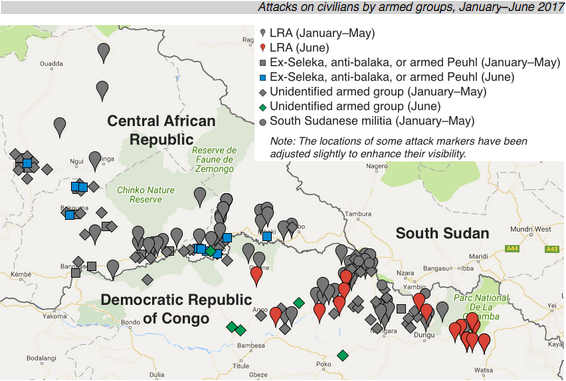
Violence in CAR spikes in Bria, spreads to Zemio
Sectarian violence has engulfed CAR’s Haute Kotto and Mbomou prefectures since March 2017, with armed groups vying for control of towns such as Bria, Bangassou, Bakouma, and Nzako, as well as key trading routes and mining sites. In June, the heaviest fighting took place in Bria, with 136 civilians killed in the third week of the month. Additional clashes took place in Nzako and Bangassou. In many incidents, civilians were targeted based on their ethnic and religious identity.
Sectarian violence also spread to neighboring Haut Mbomou prefecture, where sectarian tensions had remained relatively constrained through May 2017. Armed members of the minority Peuhl community reportedly targeted non-Peuhl civilians in Tabane and Zemio in June, often clashing with anti-balaka militias. At least 11 civilians were killed in Zemio and another 20,000 displaced, including several thousand who fled across the border to DRC’s Bas Uele province. Brief clashes also erupted further east in Mboki, but have since subsided. Troops from the United States and Ugandan militaries began withdrawing from Haut Mbomou in April, leaving a security vacuum that the Central African military (FACA) and peacekeepers from the United Nations mission in CAR (MINUSCA) have so far been unable to fill.
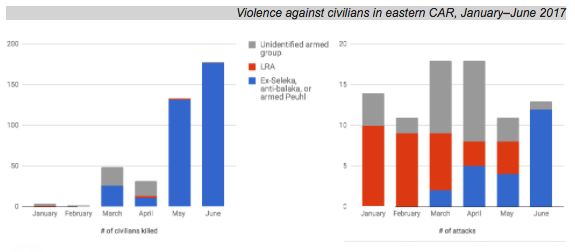
LRA continues to target communities surrounding Garamba National Park
After a nine-month absence, the LRA returned to the Garamba area in May 2017, committing 17 attacks on Congolese communities en route to the park from the border with CAR. LRA violence near the park continued in June, with an additional ten attacks and 26 abductions. During two attacks in June south of the park near Gangala na Bodio, LRA forces attacked artisanal mining sites, looting gold, diamonds, and cash. LRA attacks on communities near Garamba have historically been correlated with LRA combatants poaching elephants in the park. In early July, Congolese civilians reported seeing LRA groups transporting ivory on three separate occasions.
Testimony from two Central African abductees who escaped the LRA in Gangala na Bodio in June indicates that the LRA group operating near Garamba is led by senior commanders Owila and Ladere. Owila has periodically been tasked with transporting ivory poached from elephants in Garamba, and he was promoted in late 2014 for successfully delivering 40 tusks to LRA leader Joseph Kony in the Kafia Kingi enclave.
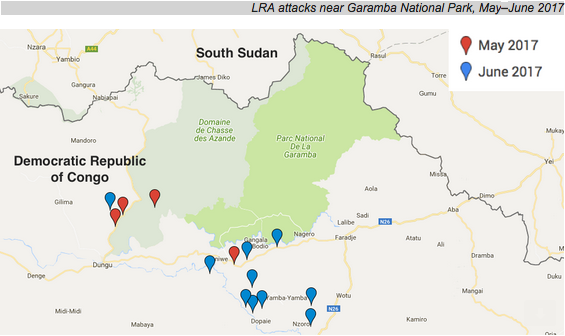
LRA violence in 2017 reduced compared to previous years
The LRA committed a total of 83 attacks and 264 abductions in the first six months of 2017, a significant reduction compared to levels of violence at the midyear points of 2014, 2015, and 2016. The drop in LRA violence has been particularly dramatic in eastern CAR, where the rebel group abducted 78 civilians in the first half of 2017, compared to 341 in the first half of 2016. In comparison, LRA abductions in DRC in the first half of 2017 (186) were higher than those at the midyear point of 2016 (160). The shift in LRA activity from eastern CAR to northern DRC in 2017 may be linked to the increased activity by ex-Seleka and anti-balaka groups in eastern CAR in 2017, as the LRA has historically sought to minimize clashes with other armed groups there. Though the LRA enjoyed a brief period of limited cooperation with ex-Seleka leaders from late 2013 through mid-2015, both ex-Seleka and anti-balaka groups have taken a more hostile posture towards the LRA since 2016.
A vast majority of the 264 people abducted by the LRA in the first of half of 2017 were adults who the LRA forced to porter looted supplies and then released within several days. The LRA abducted eight children in the first half of 2017, compared with 63 in the first half of 2016, when the LRA launched a child recruitment drive in eastern CAR. However, on July 11, LRA forces abducted four boys in DRC and told a hunter they were seeking to abduct more, which could signal a shift towards recruitment in the coming weeks.
The strategic direction of the LRA, including whether it plans to try to take advantage of the withdrawal of US and Ugandan military forces in order to rebuild, remains unclear. The LRA’s internal decision-making processes are notoriously opaque, with LRA defectors historically providing the most insight into the leadership’s plans and strategy. However, no adult male Ugandan combatants have defected from the LRA since February 2017, before the US and Ugandan withdrawal was announced.
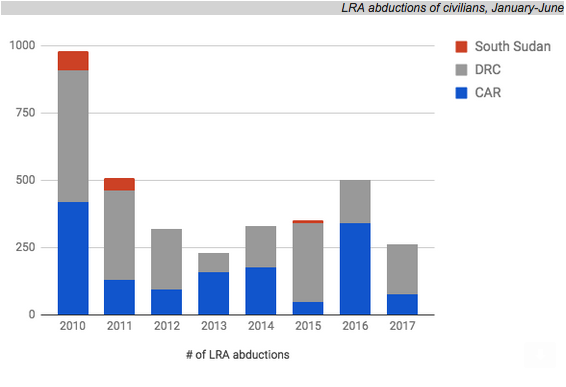
Programmatic updates
In Obo, CAR, the Invisible Children team worked with the Civil Affairs unit at MINUSCA to organize a workshop on the prevention and resolution of intercommunal conflict with the support of religious and political leaders. The workshop aimed to foster dialogue about how to mitigate sectarian tensions and expand the role of community leaders in preventing intercommunal conflicts. 31 community members, including representatives from Invisible Children-supported Peace Committees, participated in the workshop. Invisible Children staff also participated in a regional learning exercise led by Peace Direct in which participants examined and compared early warning tools deployed in Central and East Africa and sought to develop ideas for how these tools could be applied in the Beni region of DRC’s North Kivu province.
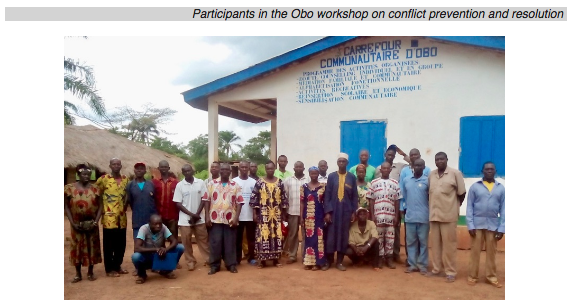
In cooperation with international humanitarian agencies and AFASVR (one of our local partners), the Invisible Children team was able to facilitate the reunification of eight LRA escapees with their families in Bria and Bangassou. The escapees had spent between one and six years in the LRA, including a 14-year-old girl who spent one year in captivity.
In addition, Invisible Children funded a medical training conducted by local doctors and nurses in Obo in which 16 former LRA abductees received a certificate to become health officers. The 16 participants in the training were members of the locally-run LRA Victims’ Associations of Mboki and Obo, which includes former LRA abductees.
Think people should hear about this?